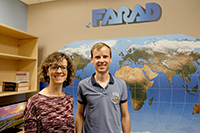December 13, 2016
Belgian veterinary researcher enjoys family atmosphere at K-State during three-month visit to learn advanced compartmental modeling

Medicine in motion: This is a literal translation of the science of pharmacokinetics. An effort to better understand how medicines move in and through animal populations brought Belgian researcher Mathias Devreese to Kansas State University in September to learn advanced compartmental modeling with pharmacokinetics experts in the Institute of Comparative Computational Medicine, or ICCM, in the College of Veterinary Medicine.
Devreese left recently with new knowledge and a strong sense of new family.
"Since the day I got here, I found that people are really friendly here and you really feel part of the K-State family," said Devreese, who is an assistant professor at Ghent University in Belgium. "Here it's like one big family. Back home, the university is one big place, but it's all scattered around the city, so you don't really feel that connection with other colleges or other faculties."
Devreese has worked closely with Ronette Gehring, associate professor in the anatomy and physiology department in the College of Veterinary Medicine. He also has been working with Jim Riviere, director of the Institute of Comparative Computational Medicine, MacDonald endowed chair in Veterinary Medicine, Kansas Bioscience eminent scholar and university distinguished professor. Devreese's visit to K-State was supported by a grant from the Fleming Research Foundation.
"Mathias was an absolute joy to interact and work with," Riviere said. "His European perspective also broadened many of our discussions related to our developing global food animal residue avoidance program. Such international study visits are a clear example of the drawing power of the ICCM."
Gehring said it has been rewarding to host Devreese.
"We have many common interests, including pharmacokinetic and pharmacodynamic modeling, drug and contaminant residues in foods of animal origin, and antimicrobial resistance," Gehring said. "Our students and postdocs benefited from interacting with a faculty member from another institution and continent, and we all gained a fresh perspective on shared research topics."
At Ghent University, Devreese said pharmacokinetic studies are conducted on a wide variety of animal species, including pigs, poultry, cockatiels, dogs and cats.
"I was looking for a lab that has great expertise in pharmacokinetics modeling," he said. "I searched several publications like Scholar, PubMed, etc. I came to the ICCM eventually. Dr. Riviere and Dr. Gehring both have lots of publications on that particular subject I was looking for."
"I brought a lot of datasets to model here, and we've been through all of them," Devreese said. "I'm pretty pleased with my stay here. I've learned lots with all the analysis we had to do — mainly learning to work with the software. It's just like I expected and hoped for."
But his visit has not been spent entirely looking at graphs and data on computers.
"In Belgium, we're really into cycling, so the day I got here, I bought myself a bicycle," Devreese said. "I've been riding it back and forth to my home here and the university every day. I really enjoy cycling on the weekends because the Flint Hills are really amazing. It's really scenic. Also, the weather has been really nice here. It's like Belgium summer here all the time, so that was really beneficial for cycling on the weekends and the evening."
Because his experience has been so rewarding, Devreese has sought to give students at both universities similar opportunities.
"I've been in contact with the international exchange officer here, and we would like to set up an exchange between Ghent University and Kansas State University," Devreese said. "The idea would be that one final-year student from Ghent would come here and one last-year student from K-State would go to Ghent for a couple of weeks or months to learn more about clinical practice. It would be very helpful to get another view of clinical practice and more experience because, for instance, the beef cattle here are very different than the Belgian White Blue breed, whose calves always have to be born by caesarian section. This breed has so much muscle it can't give natural birth, so I think it would be really interesting for K-State students to come learn in Ghent where our veterinarians do 10 caesarian sections a day during calving season. We can really exchange knowledge, and clinical experience and practices."
The Doctor of Veterinary Medicine degree programs at the two institutions also are different. At Ghent University, students can enter the program at the undergraduate level. They must study for six years rather than the four years at the graduate level in the United States. Devreese said the first couple of years in the Ghent program focus on basic sciences, anatomy and physiology. As students become more advanced, they go into clinical sciences in their third, fourth and fifth years.
Devreese said he also enjoyed interacting with the veterinary faculty while at K-State.
"Every Monday here, there's a journal club," Devreese said. "That has been really interesting to learn the American point of view versus European point of view. For instance, on an issue such as antimicrobial resistance, I hope one day we could align folks on both continents in their efforts, because it's a global issue and a global problem. If you line up with each other, that would be great."
